I was involved with European sounding rockets as graduate student and have been principal investigator or co-investigator on several NASA sounding rocket missions since. Sounding rockets permit in situ measurements at altitudes not accessible to balloons or orbiting satellites - and independent of weather. My primary application is neutral density, temperature and turbulence measurements with ionization gauges. I collaborate with the University of Alaska and the Institute of Atmospheric Physics, which builds special ionization gauges for high data rates. The time series of neutral density fluctuations can be interpreted as one-dimensional cut through spatially "frozen-in-time" turbulent layers, and are analyzed with Fourier or wavelet methods. The strength and distribution of turbulence in the atmosphere is highly variable ("intermittent"), so several measurements are better than one. Turbulence heats the atmosphere by kinetic energy dissipation, but it also quickly mixes heat and constituents ("eddy diffusion"). The viscous length scale, at which the cascading of turbulent energy turns into random motion (Kolmogorov, 1941), becomes larger with decreasing density, and near 100 km, we observe the "turbopause", where turbulence ends (as we know it) and molecular diffusion reigns. On the other hand, between 100 and 110 km, we observe very large wind speeds ("thermospheric jets") and unstable shears, and the atmosphere is still capable of vigourous gravity wave breaking and generation of instabilities. We can compare our data to detailed computer simulations of gravity wave breaking for a better understanding of turbulence in the upper atmosphere, and how the parameterization of eddy diffusion can be optimized in global circulation models. A new rocket and ground-based experiment, VortEx, to be launched from Norway in 2022, aims at characterizing the horizontal wind field at "mesoscales" (10-100 km) and between 90 and 120 km altitude.
Further reading: Fritts et al., 2017; Liu, CEDAR 2010, pdf, Lehmacher et al., 2019 (pdf).
For the lower thermosphere, I fly commercial-of-the-shelf cold-cathode and hot-cathode ionization gauges to observe the atmospheric structure at sub-kilometer scales. Obtaining absolute densities and accurate density gradients for temperatures requires careful calibration and numerical modeling of the supersonic flow environment, since the measurement of the pressure gauge is often near the stagnation point, at the highest pressure within the flow regime. The pressure reading can be 10 to 40 times larger than in the undisturbed atmosphere ("free flow"), depending on geometry and Mach number. In the lower thermosphere we encounter a rarefied, supersonic, molecular gas flow, which develops only weak shock effects around the payload. Currently we run a parallelized DSMC code on the Palmetto high-performance cluster to calculate the necessary pressure and density corrections. In the mesosphere, where densities are 10,000 times larger, the shock fronts become sharper (and computational demands increase). For the AZURE experiment (2019) we compared hot-cathode and cold-cathode gauges on the same flight.
Further reading: Lehmacher et al., 2013.
The Jicamarca Radio Observatory in Peru is the biggest and most sensitive 50-MHz radar in the world. Constructed at the "dip" equator, where the Earth magnetic field is horizontal, it can receive echoes from many interesting "coherent" scattering structures in the ionosphere, especially when the irregulaties are "field-aligned" with the geomagnetic field. For volume scattering, a radar is sensitive to coherent backscatter from spatial structures at half the radar wavelength ("Bragg scale"), here 3 meters. An overwhelming target is plasma turbulence created in the equatorial electrojet, a 400 m/s fast charged current moving at about 100 km altitude in a narrow channel along the magnetic equator. It is driven by horizontal and vertical electric "dynamo" fields connected to the tidal wind field. At night the fields and currents are reversed and instabilities become more varied and spread over a deeper region of the metal-ion rich E region. Another big target develops on many nights: low-density plasma bubbles are dislodged from the lower F region and rise quickly to altitudes of 1000 km, during which they often become very turbulent. Such ionospheric convective "storms" lead to dramatic looking height-time-intensity plots. Satellite communication and navigation may be disrupted and predicting such conditions is an important goal of "space weather" research.
Recently I became interested in so-called "150-km echoes", which can be observed at Jicamarca every day from morning to afternoon. Known since the 1960s, a good explanation remains elusive. They exist in the region where photoelectrons add extra energy to the plasma, and the characteristic "necklace" shape of the height-time-intensity plots is probably correlated with the local electron density. Their vertical velocities corresponds to the E x B drift of the plasma, which rises over the magnetic equator ("fountain effect"), spreads outward and causes an F region enhancement north and south of the dip equator ("Appleton anomaly"). The 150-km echoes are always modulated by short-period acoustic and gravity waves, but the intricate intensity patterns, both in time and altitude, are not well understood. Using data collected between 2005 and 2017 and comparison with ionosonde and model data, we recently proposed a mechanism that explains the layering of 150-km echoes, which is also supported by plasma theoretical calculations.
Further reading: Kudeki and Fawcett, 1993; Lehmacher et al., 2020.
From my research on polar mesospheric summer echoes (PMSE), turbulence, and equatorial neutral dynamics, I am eager to study more details of mesospheric echoes that can observed by Jicamarca every day during daytime from sunrise to sunset. Dr. Woodman, the long-time director of the Jicamarca radar, was the pioneer of the mesosphere-stratosphere-troposphere (MST) radar technique, in which small scale variations of the refractive index are tracers for neutral turbulence and scatter radio waves. In the troposphere and stratosphere, they are associated with pressure and humidity variations, and in the mesosphere (or rather D region), they are caused by electron density variations at the Bragg scale. From the Doppler spectrum we derive the full wind vector, and the spectral width is considered an estimate for turbulent velocity fluctuations. Horizontal winds in the equatorial mesosphere are quite variable due to the semiannual oscillation, strong, variable tides, and a multitude of gravity waves, while vertical winds display a background of short-period waves, propagating vertically or guided horizontally. While there have been many coordinated rocket and radar experiments to study PMSE, there has not been a modern experiment of simultaneous Jicamarca observations of mesospheric echoes and sounding rockets looking for turbulence and D region electron structures.
Further reading: Lehmacher et al., 2007; Lehmacher et al., 2019.

Rocket launch with mesospheric payload from Kwajalein Atoll. Photo: NASA
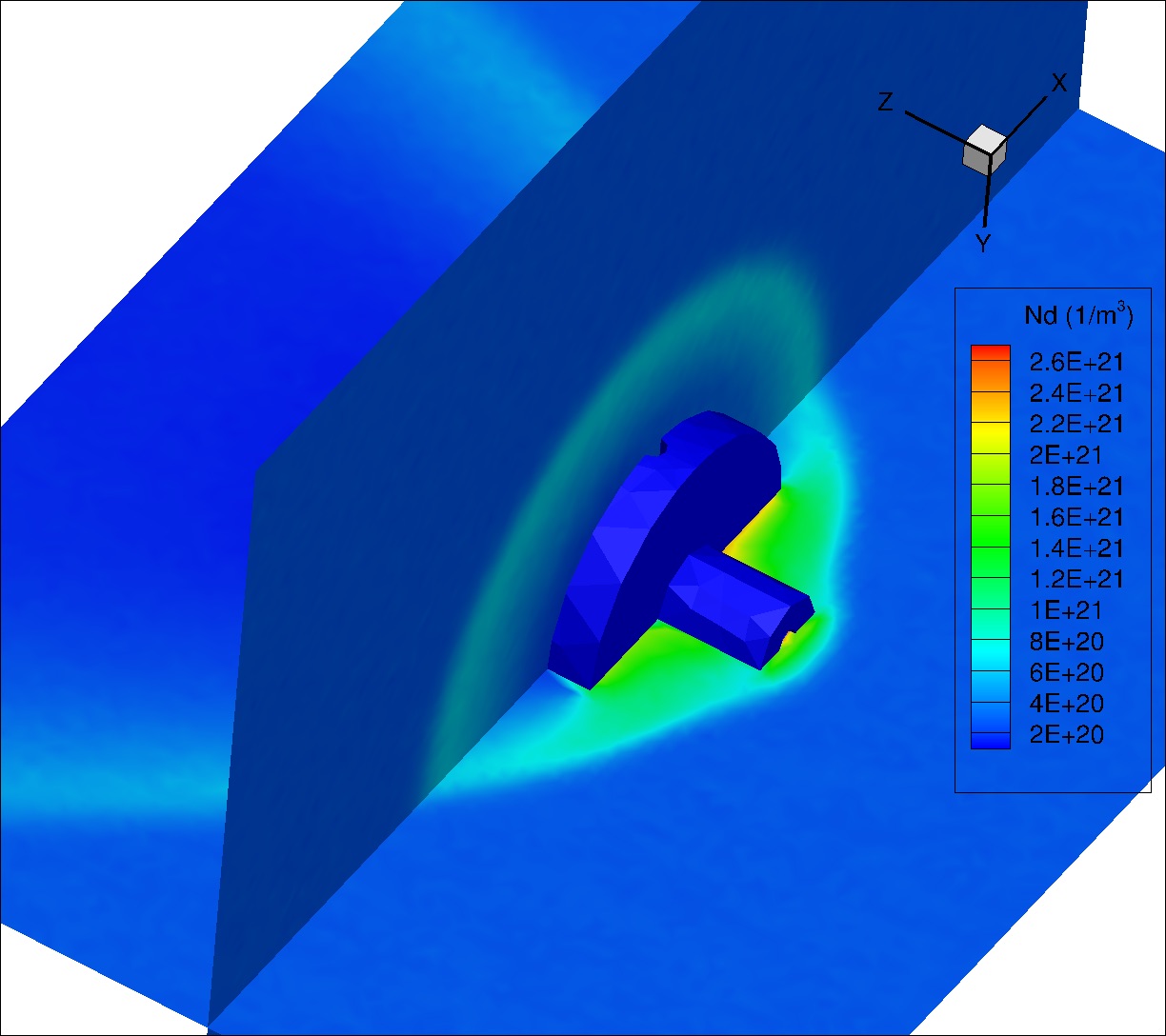
Simulation of the shock fronts around a sounding rocket payload in free fall at 80 km and Mach 3.
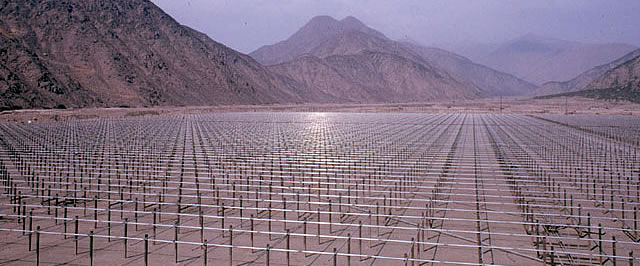
The Jicamarca main antenna array consisting of 9216 crossed dipole antennas.
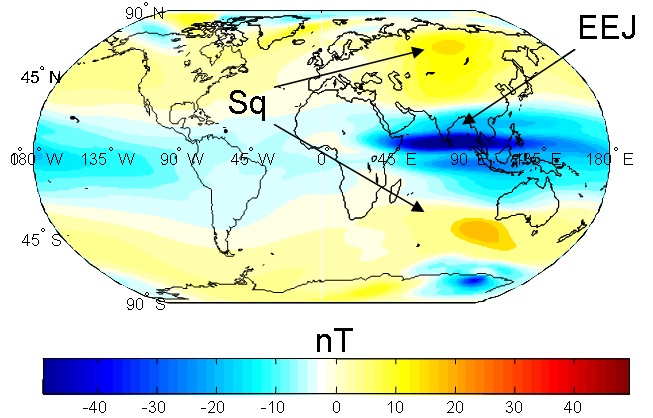
Magnetic field perturbations due to the equatorial electrojet and solar-quiet current system (model).
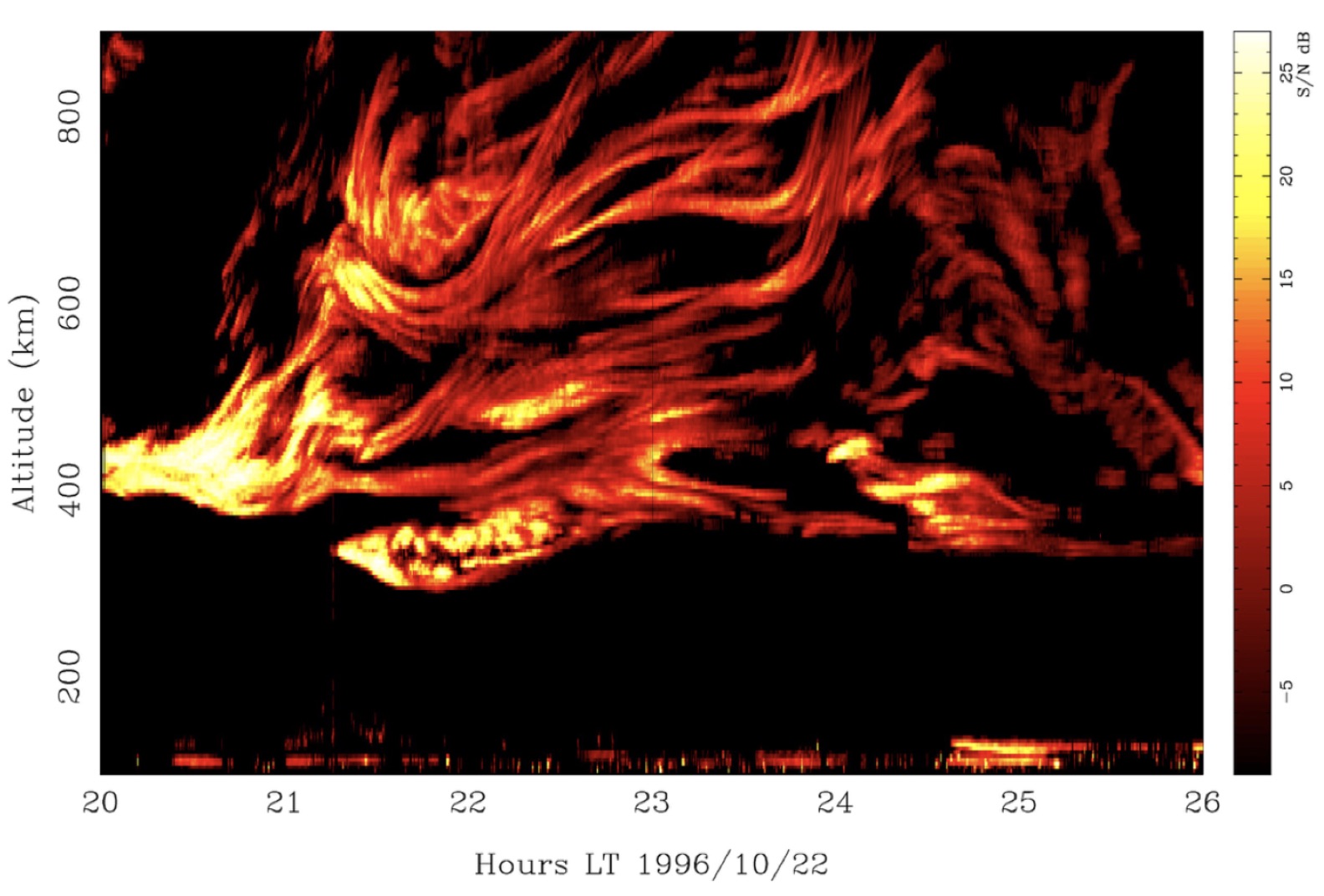
Height-time-intensity plot of equatorial convective instabilities ("Equatorial Spread-F").
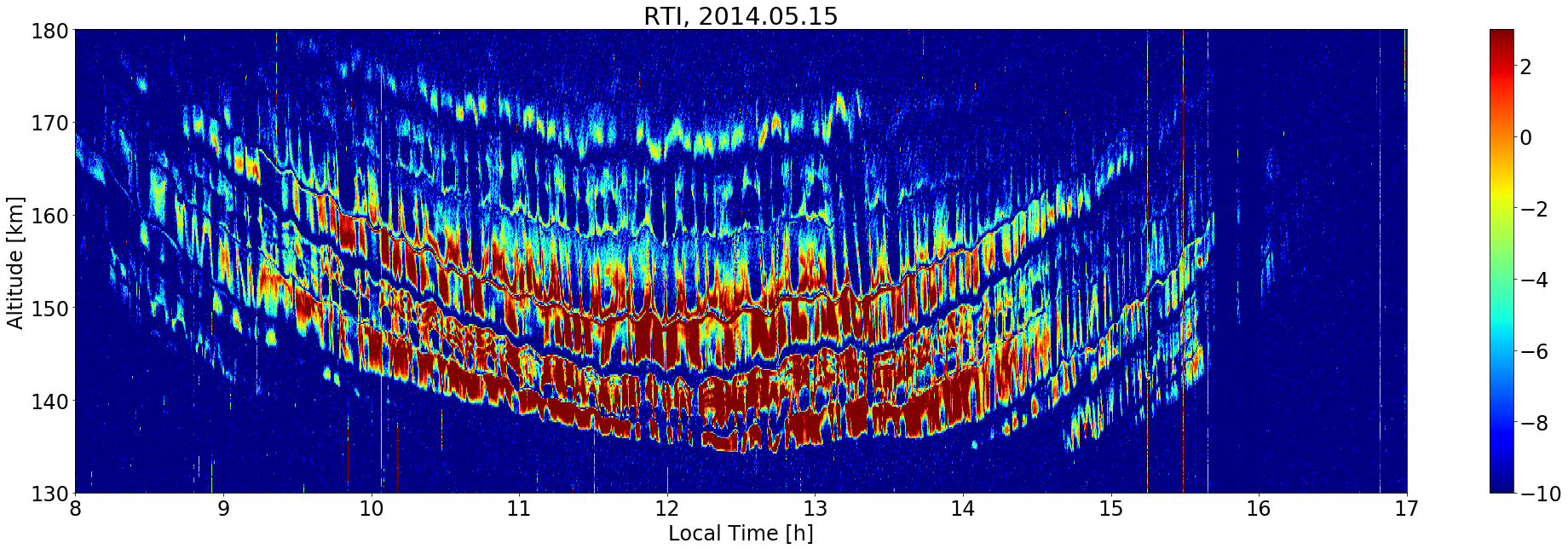
Height-time-intensity plot of 150-km echoes observed at the magnetic equator.
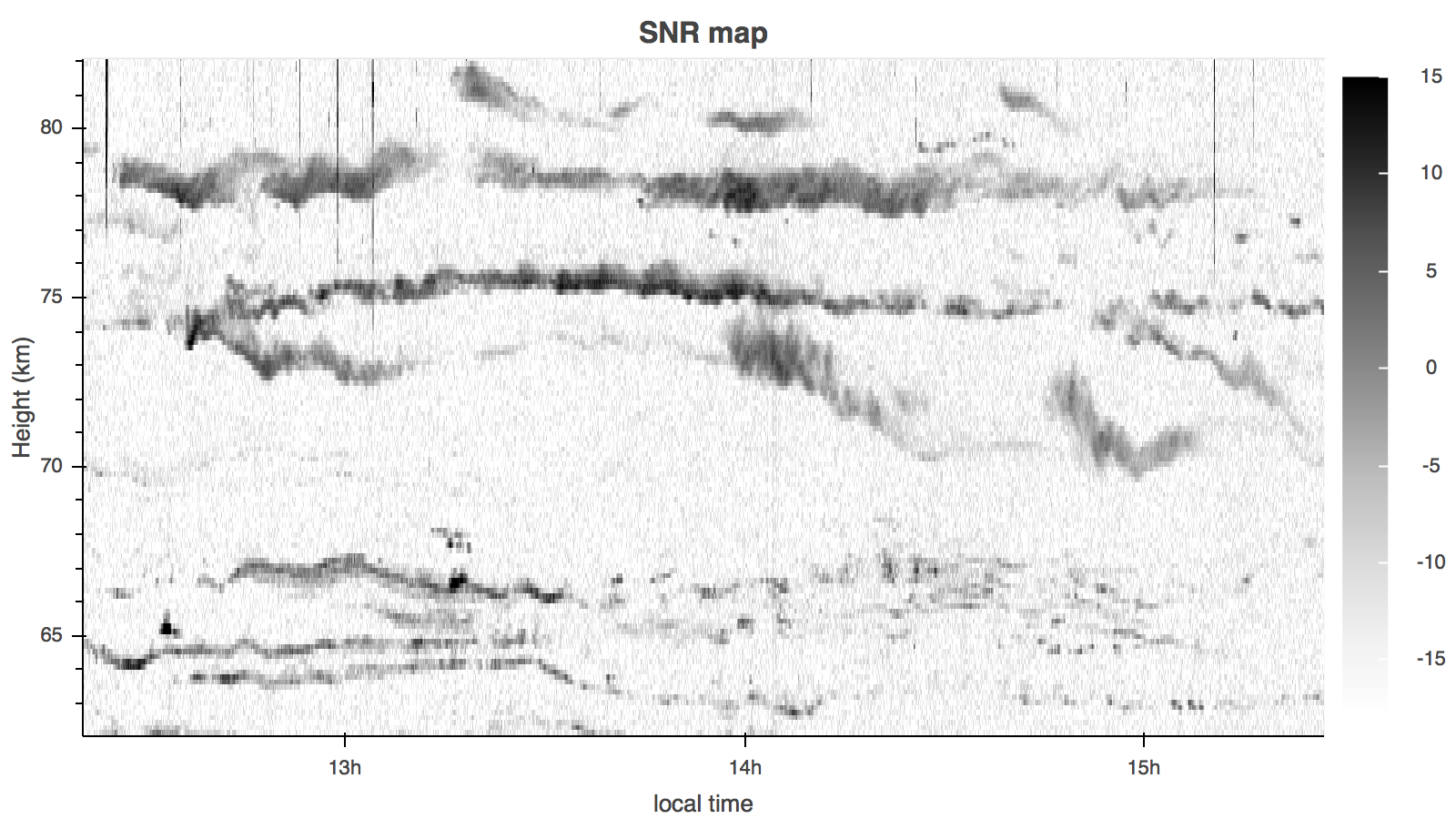
Height-time-intensity plot of mesospheric turbulent echoes observed in the D-region.